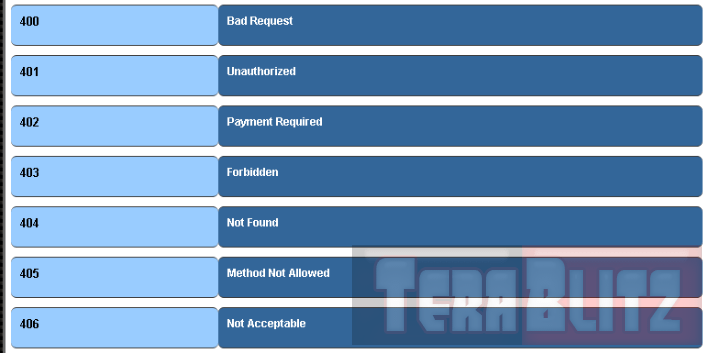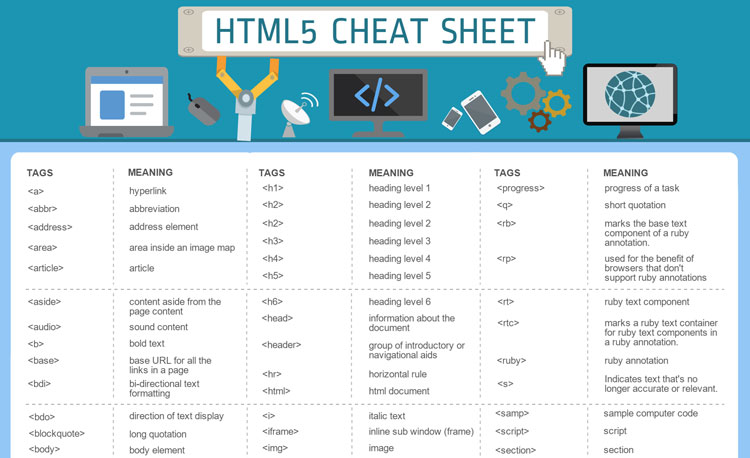HTML CHEAT SHEET Berners-Lee invented it back in 1991. Today HTML5 is the standard version and it's supported by all modern web browsers. Our HTML cheat sheet gives you a full list of all the HTML elements, including descriptions, code examples and live previews. Simply scroll down to browse all HTML tags alphabetically or browse tags by their category.
- Modify the HTTP request. Alternative Services. HTTP cheat sheet. Scripting browser-like tasks. HTTP with libcurl. Libcurl internals. Powered by GitBook. HTTP cheat sheet.
- Use this HTTP status codes cheat sheet to improve the future performance of your website. Make sure you perform a monthly website maintenance to detect errors faster and resolve them timely. Eventually, you'll make your online business a more attractive place for both visitors and search engines.
A cheat sheet (also cheatsheet) or crib sheet is a concise set of notes used for quick reference.
Cheat sheets are so named because they may be used by students without the instructor's knowledge to cheat on a test. However, at higher levels of education where rote memorization is not as important as in basic education, students may be permitted to consult their own notes (crib notes, or crib sheet) during the exam (which is not considered cheating). The act of preparing a crib sheet can be an educational exercise, and students are sometimes only allowed to use crib sheets they have written themselves.


A cheat sheet is a physical piece of paper, often filled with equations and/or facts in compressed writing. Students often print cheat sheets in extremely small font, fitting an entire page of notes in the palm of their hands during the exam.
Crib sheets are also fully worked solutions for exams or work sheets normally handed out to university staff in order to ease marking (grading).
As reference cards[edit]
In more general usage, a crib sheet is any short (one- or two-page) reference to terms, commands, or symbols where the user is expected to understand the use of such terms but not necessarily to have memorized all of them. Many computer applications, for example, have crib sheets included in their documentation, which list keystrokes or menu commands needed to achieve specific tasks to save the user the effort of digging through an entire manual to find the keystroke needed to, for example, move between two windows. An example of such a crib sheet is one for the GIMP photo editing software.[1] Other examples include 'Read Me First' and 'Quick Reference Card' documents included with consumer electronics.
Some academic and technical publishers also publish crib sheets for software packages and technical topics. In some cases these are also intended as display items in that they are colorful and visually appealing. Web-based crib sheets, such as references to terms, commands, or symbols, have become extremely common.
The Cheat Sheet News
See also[edit]
References[edit]
- ^'GIMP Keys and Mouse Reference'. Retrieved 2008-03-08.
External links[edit]
- The dictionary definition of cheat sheet at Wiktionary

Html Code Cheat Sheet
Requests
Content types that are acceptable for the response Status: Permanent | |
Character sets that are acceptable Status: Permanent | |
Accept-Language | List of acceptable human languages for response Status: Permanent |
Authentication credentials for HTTP authentication Status: Permanent | |
Used to specify directives that MUST be obeyed by all caching mechanisms along the request/response chain Status: Permanent | |
What type of connection the user-agent would prefer Status: Permanent | |
The length of the request body in octets (8-bit bytes) Status: Permanent | |
A Base64-encoded binary MD5 sum of the content of the request body Status: Permanent | |
The MIME type of the body of the request (used with Status: Permanent | |
The date and time that the message was sent (in Status: Permanent | |
Indicates that particular server behaviors are required by the client Status: Permanent | |
The email address of the user making the request Status: Permanent | |
The domain name of the server (for virtual hosting), and the TCP port number on which the server is listening. The port number may be omitted if the port is the standard port for the service requested. Mandatory since HTTP/1.1. Although domain name are specified as case-insensitive, it is not specified whether the contents of the Host field should be interpreted in a case-insensitive manner and in practice some implementations of virtual hosting interpret the contents of the Host field in a case-sensitive manner Status: Permanent | |
Only perform the action if the client supplied entity matches the same entity on the server. This is mainly for methods like Status: Permanent | |
Allows a Status: Permanent | |
Allows a Status: Permanent | |
If the entity is unchanged, send me the part(s) that I am missing; otherwise, send me the entire new entity Status: Permanent | |
Only send the response if the entity has not been modified since a specific time Status: Permanent | |
Limit the number of times the message can be forwarded through proxies or gateways Status: Permanent | |
Implementation-specific headers that may have various effects anywhere along the request-response chain Status: Permanent | |
Authorization credentials for connecting to a proxy Status: Permanent | |
Request only part of an entity. Bytes are numbered from 0 Status: Permanent | |
This is the address of the previous web page from which a link to the currently requested page was followed. The word “referrer” is misspelled in the RFC as well as in most implementations Status: Permanent | |
The transfer encodings the user agent is willing to accept: the same values as for the response header Status: Permanent | |
The user agent string of the user agent Status: Permanent | |
Informs the server of proxies through which the request was sent Status: Permanent | |
A general warning about possible problems with the entity body Status: Permanent | |
An HTTP cookie previously sent by the server with Set-Cookie Status: Permanent - Standard | |
Initiates a request for cross-origin resource sharing (asks server for an Status: Permanent - Standard |
Common Non-Standard Request Headers
Mainly used to identify Ajax requests. Some JavaScript frameworks send this field with value of
|

Responses

Content-Types that are acceptable for the response Status: Permanent | |
Specifying which web sites can participate in cross-origin resource sharing Status: Provisional | |
Used in redirection, or when a new resource has been created. This refresh redirects after 5 seconds: Status: Proprietary/non-standard: a header extension introduced by Netscape and supported by most web browsers | |
Gives the date/time after which the response is considered stale Status: Permanent - Standard | |
Strict-Transport-Security | A HSTS Policy informing the HTTP client how long to cache the HTTPS only policy and whether this applies to subdomains Status: Permanent - Standard |
Specifies which patch document formats this server supports Status: Permanent | |
What partial content range types this server supports Status: Permanent | |
The age the object has been in a proxy cache in seconds Status: Permanent | |
Valid actions for a specified resource. To be used for a 405 Method not allowed Status: Permanent | |
Tells all caching mechanisms from server to client whether they may cache this object. It is measured in seconds Status: Permanent | |
Options that are desired for the connection Status: Permanent | |
The type of encoding used on the data Status: Permanent | |
Content-Length | The length of the response body in octets (8-bit bytes) Status: Permanent |
An alternate location for the returned data Status: Permanent | |
A Base64-encoded binary MD5 sum of the content of the response Status: Permanent | |
An opportunity to raise a 'File Download' dialogue box for a known MIME type with binary format or suggest a filename for dynamic content. Quotes are necessary with special characters Status: Permanent | |
Where in a full body message this partial message belongs Status: Permanent | |
Date | The date and time that the message was sent (in Status: Permanent |
An identifier for a specific version of a resource, often a message digest Status: Permanent | |
The last modified date for the requested object (in Status: Permanent | |
Used to express a typed relationship with another resource, where the relation type is defined by RFC 5988 Status: Permanent | |
Used in redirection, or when a new resource has been created Status: Permanent | |
This header is supposed to set P3P policy, in the form of Status: Permanent | |
Implementation-specific headers that may have various effects anywhere along the request-response chain Status: Permanent | |
Request authentication to access the proxy Status: Permanent | |
If an entity is temporarily unavailable, this instructs the client to try again later. Value could be a specified period of time (in seconds) or a HTTP-date Status: Permanent | |
Trailer | The Trailer general field value indicates that the given set of header fields is present in the trailer of a message encoded with chunked transfer-coding Status: Permanent |
The form of encoding used to safely transfer the entity to the user. Currently defined methods are: chunked, compress, deflate, gzip, identity Status: Permanent | |
Ask the server to upgrade to another protocol Status: Permanent | |
Tells downstream proxies how to match future request headers to decide whether the cached response can be used rather than requesting a fresh one from the origin server Status: Permanent | |
A general warning about possible problems with the entity body Status: Permanent | |
Indicates the authentication scheme that should be used to access the requested entity Status: Permanent |
Common Non-Standard Response Headers
Cheat Sheet Http Error Codes
Clickjacking protection:
| |
Content-Security-Policy, | Content Security Policy definition |
The only defined value, | |
Specifies the technology (e.g. ASP.NET, PHP, JBoss) supporting the web application (version details are often in X-Runtime, X-Version, or X-AspNet-Version) | |
Recommends the preferred rendering engine (often a backward-compatibility mode) to use to display the content. Also used to activate Chrome Frame in Internet Explorer |
